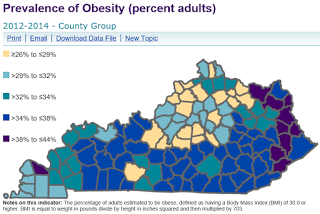Tackling obesity in Kentucky can be a touchy subject

 |
| KentuckyHealthFacts.org map; click on it for larger version |
SLADE, Ky. — Among the topics covered in “Covering Health: A News Workshop” Nov. 11 at Natural Bridge State Resort Park was one of Kentucky’s biggest pairs of health problems: obesity and diabetes.
Reporting on obesity can be intimidating for journalists, said Danielle Ray, graduate intern at the Institute for Rural Journalism and Community Issues, who presented on the topic. “It’s a really awkward topic to approach,” she said. “You feel like you’re embarrassing people.” Reporting the facts about obesity is not intended to shame people, she said, noting that readers, viewers and listeners are at risk for life-threatening, yet preventable obesity-related illnesses, especially those in rural Kentucky counties.
Kentucky’s obesity rate is the nation’s fifth highest, with nearly 35 percent of adults categorized as obese on the basis of their height and weight. That number has been rapidly climbing for more than 25 years, according to the State of Obesity report. In 2000, about 22 percent of Kentuckians were obese; in 1990 the figure was less than 13 percent.
 |
| County-level map from KentuckyHealthFacts.org |
Obesity is associated with diabetes and hypertension, or high blood pressure. Kentucky ranks fourth in the nation for diabetes, with more than 13 percent of the adult population diagnosed with type 2 diabetes.
The state ranks sixth highest in the nation for hypertension, with 39 percent or 1.8 million Kentuckians diagnosed with high blood pressure.
Hypertension, like diabetes, puts people at risk for other serious medical problems, including stroke, heart attack, renal disease and dementia.
Obesity also increases a person’s likelihood of developing other conditions like heart disease, arthritis and cancer.
Childhood obesity may be an even greater problem in the state. Kentucky has the third highest rate of obese high-school-aged children, nearly 20 percent. Childhood obesity becomes intertwined with other factors that make the cycle hard to break. Most notably, children from low-income families are at a greater risk of obesity and its subsequent health problems, the report notes.
The workshop was presented with support from the Foundation for a Healthy Kentucky, which funds the rural-journalism institute to produce Kentucky Health News. The institute is part of the School of Journalism and Media in the College of Communication and Information at the University of Kentucky.
To find local information on obesity, visit Kentucky Health Facts or County Health Rankings.